
Why farmers should plant trees now, and manage them for the mass timber buildings of the future
Posted 30 October 2020
Managing trees Economic benefits and markets
Michael Lee from the Centre for Sustainable Architecture with Wood (CSAW) at the University of Tasmania has been working with the Tasmanian timber resource for around 25 years.
The role of CSAW, which is a research and education unit under the Faculty of Architecture and Design, is to help the Tasmanian industry to get sustainable timber products into the built environment. The focus of much of their current research?
Plantation grown hardwood – and according to Michael, it’s become really exciting.
Traditionally the Tasmanian industry was converting a round log into a square board, then taking it to someone else. Michael says the market's changing. People are asking for product solutions and it's become really exciting.
“We're making better usage of the material we have. We've got a saturation of sales and we're looking for new products,” says Michael. “So, we’re looking at the plantation resource.”
Michael explains that the major perception they’re setting out to change, is that plantation grown hardwood is a replacement for the native grown resource.
“It’s not, it's a new product. We have a small amount of sustainably grown and harvested native forest timber that will continue to fill a market.
“But this new market we have and the potential we have for mass timber is really out of this plantation material. Its high rotation, quick turnover, and it is a new product in its own right. And that's where the research work is focusing. The research is going to explode. Mass timber laminates - things like Glue Laminated Timber (GLT), and Cross Laminated Timber (CLT), there's huge potential.”
CSAW have gone from a team of three or four to now a team of 20 across seven projects. And it's not just a small Tasmanian ethos, it's a whole of Australia push to examine how we can get sustainable timbers into big built environments.
“Mass timber buildings will be here. They will be here within the decade. And Tasmania definitely has the type of resource and the critical mass to actually enter into this market,” explains Michael.
Worldwide demand for timber set to explode
Worldwide demand for timber is going to put pressure on both the native and traditional timber supplies in Australia. Michael explains that policy around the world is shifting to prioritise the use of timber with mass laminated timbers replacing concrete and steel worldwide.
“In France from 2022, 50% of a building will need to be sustainable - and the biggest thing in delivering that is going to be timber,” says Michael.
“So, the timber that was coming into Australia from Europe, and there's a lot of CLT coming out of Europe, is now going to be sold within Europe.
“We're importing masses of this material, which can be replaced by eucalypts out of our plantations here in Tasmania. So, the opportunity is to go into CLT based products like this. We're doing a lot of work with the manufacturers of these type of products.
The Plantation Opportunity
The two species being trialled at the present time are Eucalyptus nitens and Eucalyptus globulus. Both of them very quick growing.
“I'm very confident. The difference in the sales price is going to be quite marked. We have had a huge amount of success in 26-year-old nitens that have been properly silviculturally thinned and pruned. A lot of this material has already gone into the marketplace at a price that that's been very commercially acceptable.”
CSAW have produced an acoustic panel made out of undocked high feature material from the plantation forests, which was grown for wood chip.
“In reality, I've got a two and a half thousand-dollar acoustic panel here, which probably has three or $4 worth of wood chips value.”
The response from the marketplace is very positive – but according to Michael, we haven't got enough resource to satisfy the demand.
“Architects are very, very excited. They're very well aware that this material was going to wood chip. It's totally blown them away.”
The stock that's out there now is managed for fibre. It's a product that's been repurposed. Michael explains that if landowners were to actually manage plantations correctly for this purpose, they would get a much better return.
“I would really encourage farmers that are thinking about planting trees to do so. There has never been a better time and the time will be in the next decade.
“They will be well-placed by the time that the trees even come to the 16-year-old mark to feed into the technologies have been developed and actually embraced in Tasmania.”
Image credit: Image of staircase - Photographer John Gollings






